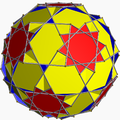Medial disdyakis triacontahedron
Look at other dictionaries:
Medial rhombic triacontahedron — Type Star polyhedron Elements F = 30, E = 60 V = 24 (χ = −6) Symmetry group Ih, [5,3], *532 … Wikipedia
Medial deltoidal hexecontahedron — Type Star polyhedron Elements F = 60, E = 120 V = 54 (χ = −6) Symmetry group Ih, [5,3], *532 … Wikipedia
Medial pentagonal hexecontahedron — Type Star polyhedron Elements F = 60, E = 150 V = 84 (χ = −6) Symmetry group I, [5,3]+, 532 … Wikipedia
Dodecadodecahedron — Type Uniform star polyhedron Elements F = 24, E = 60 V = 30 (χ = −6) Faces by sides 12{5}+12{5/2} Wythoff symbol … Wikipedia
Snub dodecadodecahedron — Type Uniform star polyhedron Elements F = 84, E = 150 V = 60 (χ = −6) Faces by sides 60{3}+12{5}+12{5/2} Wythoff symbol … Wikipedia
Truncated great dodecahedron — Type Uniform star polyhedron Elements F = 24, E = 90 V = 60 (χ = −6) Faces by sides 12{5/2}+12{10} Wythof … Wikipedia
Truncated great icosahedron — Type Uniform star polyhedron Elements F = 32, E = 90 V = 60 (χ = 2) Faces by sides 12{5/2}+20{6} Wythoff symb … Wikipedia
Kepler–Poinsot polyhedron — In geometry, a Kepler–Poinsot polyhedron is any of four regular star polyhedra. They may be obtained by stellating the regular convex dodecahedron and icosahedron, and differ from these in having regular pentagrammic faces or vertex figures.… … Wikipedia
Nonconvex great rhombicosidodecahedron — Type Uniform star polyhedron Elements F = 62, E = 120 V = 60 (χ = 2) Faces by sides 20{3}+30{4}+12{5/2} … Wikipedia
Tetrahedron — For the academic journal, see Tetrahedron (journal). Regular Tetrahedron (Click here for rotating model) Type Platonic solid Elements F = 4, E = 6 V = 4 (χ = 2) Faces by s … Wikipedia


